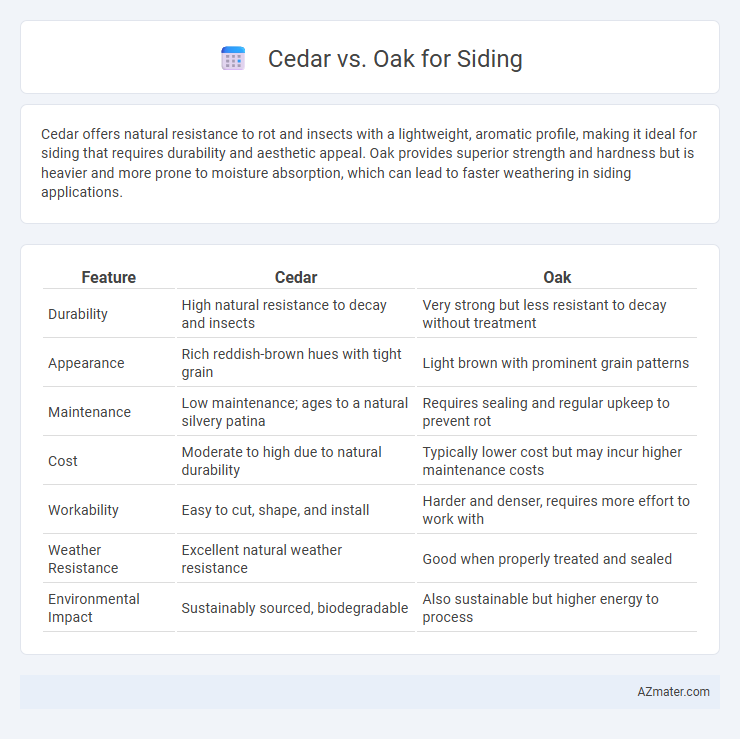Cedar offers natural resistance to rot and insects with a lightweight, aromatic profile, making it ideal for siding that requires durability and aesthetic appeal. Oak provides superior strength and hardness but is heavier and more prone to moisture absorption, which can lead to faster weathering in siding applications.
Table of Comparison
| Feature | Cedar | Oak |
|---|---|---|
| Durability | High natural resistance to decay and insects | Very strong but less resistant to decay without treatment |
| Appearance | Rich reddish-brown hues with tight grain | Light brown with prominent grain patterns |
| Maintenance | Low maintenance; ages to a natural silvery patina | Requires sealing and regular upkeep to prevent rot |
| Cost | Moderate to high due to natural durability | Typically lower cost but may incur higher maintenance costs |
| Workability | Easy to cut, shape, and install | Harder and denser, requires more effort to work with |
| Weather Resistance | Excellent natural weather resistance | Good when properly treated and sealed |
| Environmental Impact | Sustainably sourced, biodegradable | Also sustainable but higher energy to process |
Introduction: Cedar vs Oak Siding
Cedar siding offers natural resistance to rot, decay, and insect damage, making it a durable and low-maintenance option for exterior cladding. Oak siding is known for its dense grain and strength, providing superior durability but requiring more maintenance to protect against moisture and pests. Choosing between cedar and oak siding depends on balancing aesthetic preferences with long-term performance and environmental conditions.
Wood Characteristics: Cedar and Oak
Cedar siding is prized for its natural resistance to decay, insect damage, and moisture, featuring a lightweight, soft texture and aromatic qualities that enhance its durability and aesthetic appeal. Oak siding, in contrast, offers exceptional strength and hardness, with a dense grain pattern that provides superior impact resistance but requires more maintenance to prevent weathering and fungal growth. Both woods exhibit unique characteristics affecting longevity, insulation properties, and overall performance in exterior applications.
Durability and Longevity Comparison
Cedar siding offers exceptional natural resistance to rot, insects, and moisture, contributing to an average lifespan of 30-40 years with proper maintenance. Oak siding, while extremely dense and strong, is less commonly used due to its susceptibility to moisture-related issues, resulting in a shorter lifespan typically under 20 years without extensive treatment. Choosing cedar enhances durability and longevity in exterior applications, especially in humid or variable climates.
Appearance and Aesthetic Appeal
Cedar siding offers a rich, warm hue with natural knots and a smooth texture that enhances rustic and traditional aesthetics, while oak siding provides a tighter grain and a more uniform, dense appearance that suits classic and modern designs. Cedar's natural resistance to decay also allows it to develop a beautiful silver-gray patina over time, adding character and charm. Oak's durability and fine grain make it ideal for stains and finishes that highlight its sophisticated, elegant look.
Weather Resistance and Maintenance
Cedar siding offers superior natural weather resistance due to its high concentration of tannins, which protect against moisture, insects, and decay, making it ideal for damp or humid climates. Oak siding is denser and harder, providing strong durability but requires more frequent maintenance, including sealing and staining, to prevent water damage and warping. Both woods need regular upkeep, but cedar's inherent rot resistance reduces long-term maintenance efforts compared to oak.
Cost Analysis: Cedar vs Oak
Cedar siding generally costs between $3.50 and $7.00 per square foot, offering affordability and durability, while oak siding typically ranges from $6.00 to $12.00 per square foot due to its density and strength. Maintenance costs for cedar are lower because of its natural resistance to rot and insects, whereas oak may require more frequent treatments and sealing to maintain longevity. Overall, cedar presents a more cost-effective option for siding when balancing initial investment and long-term upkeep expenses.
Environmental Impact and Sustainability
Cedar siding is known for its natural resistance to decay and insects, which reduces the need for chemical treatments and contributes to its eco-friendliness. Oak, while durable, often requires more intensive processing and chemical preservatives to maintain longevity, increasing its environmental footprint. Cedar's faster growth rate and renewable harvesting practices make it a more sustainable option compared to the slower-growing oak species.
Installation and Workability
Cedar siding offers superior ease of installation due to its lightweight nature and natural resistance to warping, making it a preferred choice for complex architectural designs. Oak, while heavier and denser, requires more effort and specialized tools for cutting and fastening but provides exceptional durability and strength once installed. Both woods require proper treatment to resist moisture and pests, but cedar's softer grain allows for quicker handling and finishing during installation.
Common Applications and Styles
Cedar siding is favored for its natural resistance to moisture and insects, commonly applied in rustic, craftsman, and traditional-style homes due to its warm, rich hues and textured grain. Oak siding, known for its exceptional hardness and durability, is often used in historic restorations, colonial, and classic architectural styles, providing a more uniform, dense grain with a lighter color palette. Both woods accommodate various finishes, but cedar's flexibility in shingle and clapboard styles contrasts with oak's suitability for smooth, flat panel designs.
Choosing the Right Wood for Your Siding
Cedar siding offers natural resistance to rot, decay, and insect damage, making it an enduring choice for exterior cladding, while oak provides superior strength and durability but requires more maintenance to prevent weathering. Cedar's lightweight and stability make it easier to work with and ideal for complex architectural designs, whereas oak's dense grain enhances impact resistance and longevity in high-traffic areas. Selecting between cedar and oak for siding depends on balancing factors like climate resilience, maintenance commitment, and aesthetic preference to ensure long-term performance and curb appeal.

Infographic: Cedar vs Oak for Siding
 azmater.com
azmater.com